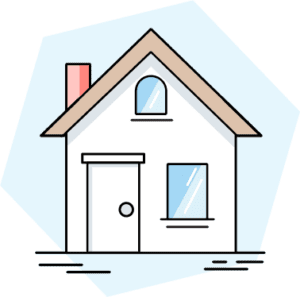HO-3 insurance, also known as special form homeowners insurance, is a popular option for Americans looking for financial protection for their home and personal belongings. It helps cover the cost of repairs after a fire, windstorm, lightning strike, or other unexpected situation.
Beyond the home itself, HO-3 insurance also offers coverage for other structures on the property and some protection against personal liability claims. Read on for details about what HO-3 insurance covers and how it works.
Table of Contents
How HO-3 Home Insurance Works

HO-3 policies are the most popular type of home insurance option because of the comprehensive coverage they offer. Specific coverages can vary from policy to policy, but typically, an HO-3 insurance policy includes six standard types of coverage:
- Dwelling coverage: It covers damage to the home’s structure, such as the foundation, walls, and roof. Dwelling coverage also includes things that are permanently attached to the house, such as your cabinets or porch.
- Other structures coverage: The other structures part covers buildings that are not attached to your home, such as a shed, gazebo, or detached garage.
- Personal property coverage: Homeowners insurance’s personal property coverage helps replace the belongings inside a damaged home, including furniture, clothing, and electronics.
- Additional living expenses coverage: Also known as loss of use coverage, it helps pay for the extra costs you face if you cannot live in your home while it’s being repaired.
- Liability coverage: This part helps cover legal fees and damage settlements if you, a member of your household, or your pet injure another person or damage their property.
- Medical payments coverage: Medical payments coverage helps pay for small medical bills if a guest is injured on your property.
Coverages
HO-3 insurance policies offer coverage for many unexpected events and disasters — also known as perils — that can damage your home and property. Check your policy for details about the specific perils it covers. Some of the common perils covered by an HO-3 insurance policy include:
- Fire
- Lightning strikes
- Windstorms and hail
- Smoke
- Theft
- Vandalism
- Weight of ice, snow, and sleet
- Damage caused by vehicles
- Falling objects, such as trees
- Riot or civil commotion
- Freezing of household systems, such as your plumbing
- Sudden leaks of water or steam from household systems
Exclusions
In an HO-3 policy, the home and other structures are covered on an “open-perils” basis, which means it pays for damage caused by any event that’s not specifically excluded. Exclusions vary from one policy to another, so it’s important to review your coverage. Events that HO-3 policies often do not cover include:
- Earthquakes
- Sinkholes
- Flooding
- Sewer backups
- Poor maintenance
- Wear and tear
- Pest infestations
- Mold damage
- Intentional damage
- Government action
Types of Home Insurance Policies
Insurers sell several different types of home insurance policies to meet different needs. Some types are for single-family homes, while others are for mobile homes or condos. The types of coverages and the covered perils vary depending on your chosen policy. The below table offers an overview of the available options.
Home Insurance Form Categories | Dwelling Type | Named or Open Peril | Dwelling Coverage | Other Structures Coverage | Personal Property Coverage | Liability Coverage | Medical Payments Coverage | Loss of Use Coverage |
|---|---|---|---|---|---|---|---|---|
HO-1, or 10 Named Perils Insurance | Single-family home | Named | Yes | Varies | No | No | No | No |
HO-2, or 16 Named Perils Insurance | Single-family home | Named | Yes | Varies | Yes | Varies | Varies | Varies |
HO-3, or Standard Home Insurance | Single-family home | Open for dwelling, Name for personal | Yes | Yes | Yes | Yes | Yes | Yes |
HO-4, or Renter’s Insurance | Rental property | Named | No | No | Yes | Yes | Yes | Yes |
HO-5, or Open Perils Insurance | Single-family home | Open | Yes | Yes | Yes | Yes | Yes | Yes |
HO-6, or Condo Insurance | Condo, co-op, or townhome* | Named | Varies | No | Yes | Yes | Yes | Yes |
HO-7, or Mobile Home Insurance | Mobile home | Open | Yes | Varies | Yes | Yes | Varies | Yes |
HO-8, or Modified Coverage Home Insurance | Varies** | Named | Yes | Yes | Varies | Varies | Varies | Varies |
** Homes that are not eligible for standard home insurance policies; criteria may differ based on state and insurer
How Much Does HO-3 Insurance Cost?

The cost of an HO-3 homeowners policy varies widely from one home to another. In 2023, American homeowners paid between $500 and $4,200 per year for $300,000 in dwelling coverage.
Insurance companies consider many factors when setting premiums for HO-3 insurance. Some key factors that affect your cost include:
- Your home’s location: The risk of severe weather-related events and the cost of repairing the resulting damage varies widely across the country.
- Your home’s age: Newer houses tend to be less expensive to insure because of their modern construction materials and building techniques.
- Your home’s construction style: Durable materials, such as brick or stucco, can lead to lower home insurance premiums.
- Your coverage limit and deductibles: Homeowners generally pay higher premiums in exchange for higher coverage limits and lower premiums if they choose a higher deductible.
Should You Consider an HO-3 Homeowners Policy?
HO-3 policies are the most popular type of homeowners insurance, but that does not mean they’re right for every homeowner. Carefully weigh the following pros and cons of HO-3 insurance before buying a policy.
- Covers a wide range of events
- Offers comprehensive coverage
- Customizable with riders
- Higher premiums than HO-2 policies
- Excludes many common disasters
- Limited personal property coverage
Pros
- Covers a wide range of events: HO-3 insurance covers damage to homes caused by any unexpected event or disaster, except those that are specifically excluded. The burden of proof is on the insurance company to show that coverage for an event is excluded.
- Offers comprehensive coverage: Some types of homeowners insurance only cover the home’s physical structure and contents. HO-3 policies offer much broader coverage, with six standard components.
- Customizable with riders: Insurance companies sell optional add-ons, known as riders, that allow homeowners to adjust their coverage to better suit their needs. For example, a business property rider adds coverage for business-related items stored in the home.
Cons
- Higher premiums than HO-2 policies: HO-3 policies cover damage from a wider range of events, and this added protection translates to higher insurance rates. For some homeowners, an HO-3 policy’s more comprehensive coverage is not worth the added cost.
- Excludes many common disasters: Homeowners who experience an excluded event are responsible for paying for repairs on their own unless they have coverage through another policy. There are standalone policies that help fill the gaps in HO-3 coverage, such as flood insurance and earthquake insurance.
- Limited personal property coverage: While HO-3 policies cover the home’s structure for all events that are not specifically excluded, they only cover personal belongings for events listed in the policy. HO-5 policies offer broader coverage for personal property.
Who Are HO-3 Policies For?

HO-3 policies are popular for homeowners with many different needs and preferences. You may want to consider an HO-3 homeowners policy if:
- You own a single-family home: The HO-3 is for owner-occupied single-family homes. There are different policies for other types of homes, such as condos and mobile homes.
- You want broad protection: As an open-perils policy, HO-3 insurance covers your dwelling for any event that is not specifically excluded.
- You have other structures on your property: HO-3 policies cover structures like sheds and detached garages, while HO-1 and HO-2 policies may not.
- You’re concerned about liability: Dog owners and people who frequently host gatherings at home may consider protection from personal liability claims essential.
- You have a mortgage on your home: Most banks and mortgage lenders require proof of adequate homeowners insurance. As a standard form of homeowners insurance, an HO-3 policy likely meets lender requirements.
What This Means For You
HO-3 insurance offers more comprehensive coverage than some other home insurance options, with six standard components in a typical policy. It helps protect your finances from a wide variety of unexpected events, from a burst pipe to a lawsuit from an injured houseguest.
An HO-3 policy is a good option for many homeowners, including those who want broad protection for a single-family home. Others may prefer the more limited coverage offered by an HO-1 or HO-2 policy or the higher level of coverage available through an HO-5. For help choosing a policy that suits your needs, work with a trusted agent.
